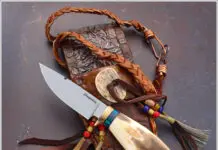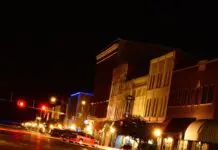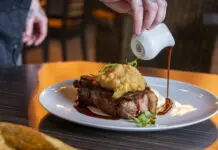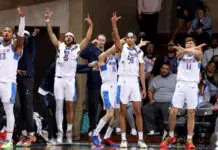Alabama at Enid Event Center

From thealabamaband.com – It’s been 40 years since a trio of young cousins left Fort Payne, Alabama, to spend the summer playing in a Myrtle Beach, South Carolina, bar called The Bowery. It took Randy Owen, Teddy Gentry and Jeff Cook six long years of tip jars and word of mouth to earn the major label deal they’d been dreaming of, but then seemingly no time at all to change the face of country music.
ALABAMA is the band that changed everything. They reeled off 21 straight #1 singles, a record that will probably never be equaled in any genre. They brought youthful energy, sex appeal and a rocking edge that broadened country’s audience and opened the door to self-contained bands from then on, and they undertook a journey that led, 73 million albums later, to the Country Music Hall of Fame and the Hollywood Walk of Fame. For tickets visit enideventcenter.com.
Square One Theatrics to help produce A Very Sordid Wedding

[dropcap]Tulsans[/dropcap] Jay Krottinger and Ryan Jude Tanner, of Square One Theatrics, have announced they will be associate producers for Del Shores’ A Very Sordid Wedding. The movie is a sequel to the actor, writer and producer’s 2000 film Sordid Lives and, for Shores, brings an Oklahoma connection to both films.
Nearly 20 years ago, Shores had given up on creating a movie adaptation of Sordid Lives because of difficulty in finding investors for the film. While he was at lunch in Los Angeles with his daughter, he had a chance encounter with an Oklahoma native that changed his mind.
“He told me because of the play, he moved back to Oklahoma and came out to his Southern Baptist family,” Shores says. “He said, ‘If you could do it with humor, I could do it and be brave enough to do it.’”
The man encouraged Shores to not give up on making the movie, and Shores decided to move ahead with the project by filming it as cheaply as possible. The budget for the Sordid Lives, which has become a cult classic and spawned a television series, was around $500,000.
Many actors from Sordid Lives, including Leslie Jordan and Bonnie Bedelia, will be appearing with Whoopi Goldberg and Caroline Rhea in A Very Sordid Wedding. The sequel catches up with the characters from Sordid Lives and looks at cultural changes that have occurred since 2000.
“Thematically, it’s what happens when equality comes storming into Texas,” Shores says. “It’s interesting in that aspect, and I loved returning to it. It wasn’t hard – all I had to do was make a phone call to the Runnels County Courthouse and see how they were handling gay marriage, and boy, did I get an earful.”
A Very Sordid Wedding marks the first time Krottinger and Tanner have been associate producers for a movie. Square One Theatrics has previously been involved in live performances, including Flipside: The Patti Page Story, the Tony-award winning Broadway show Pippin, and the Broadway show Waitress, which is nominated four Tony awards and six Drama Desk Awards this year.
Both said they were a little apprehensive because of their lack of film experience, but wanted to be part of the project. Although they look carefully at the potential financial risks and rewards of every projects, both say it is also important for them to believe in every project they help produce.
“For us, it has been really fun just because we really believe in the project, so we’ve enjoyed talking to people and trying to get other people excited about it as well,” Tanner says. “Whenever we’re talking about the piece with people, particularly people who are gays and lesbians, their excitement level goes through the roof.”
The movie also provides experience for working on additional film, something Krottinger says Square One Theatrics will be involved in again in the future.
“This is our first foray into film. We’re in the midst of working on a couple of other projects – not just Broadway related,” he says. “Currently we’re producing a documentary called Body Electric. This 90-minute documentary traces the history of gay culture and its fixation on the body. It investigates its growth through visibility, the impact of the AIDS crisis, pop culture and the advent of social media. Body Electric explores the extremism of steroid use, drugs and plastic surgery and also dives into factions within the LGBT community while also uncovering socio-economic and racial divides. It’s kind of nice to dip your toe in the water of some things, see how it all works out and allow that to be a learning process for other projects.”
Krottinger and Tanner became involved with A Very Sordid Wedding through their friendship with Leslie Jordan. Jordan, who was close friends with Tulsa interior designer Charles Faudree, has always had a special relationship with Tulsa, Tanner says.
“I met the boys many years ago when my dear friend Charles Faudree was alive,” Jordan says. “Jay and Ryan are both so damn sweet. The whole process of Sordid Lives moving from a play to a movie to a TV show on LOGO and now back to a movie has created an amazing family. We have been at this for over 20 years now, so to add Jay and Ryan to the family is very special.”
Shores shares excitement about Krottinger and Tanner becoming involved in the project.
“I was really thrilled that Ryan and Jay came on board, because they’ve done some pretty magical things in the Broadway world,” Shores says. “It was just a Godsend they came on. It was so much fun, for one thing, and they love Sordid Lives.”
A Very Sordid Wedding has finished its first round of filming and will conclude filming during a four-day session in Dallas. Although no release date has been set, Krottinger and Tanner say they’re hoping for a release sometime this year and to premiere the movie in Tulsa.
Shores says the movie will likely be the last time he revisits the characters from Sordid Lives, meaning Krottinger and Tanner will have helped bring a much-anticipated conclusion to a journey that has lasted 20 years – one that was helped along by another anonymous Oklahoman.
“He’s the real reason we did the film of Sordid Lives,” Shores says. “Sometimes I wish I could find him just to thank him.”
Wingapalooza

From bokcenter.com –
SMG Special Events and BOK Center are excited to announce Wingapalooza presented by Tulsa Federal Credit Union, as it returns for it’s third year on Saturday, June 11, 2016 at BOK Center. This one-of-a-kind event features several Tulsa-area restaurants showcasing their various wing preparation styles. Restaurants will compete for several awards including People’s Choice.
General Admission tickets are $25 (Additional Fees May Apply)
VIP Tickets are $75 (Additional Fees May Apply) and this includes access to the ONEOK Club where you get to skip the lines. You’ll get to enjoy wings from all the vendors without having to wait in lines and soda and domestic beer is also provided.
For tickets and more information visit bokcenter.com.
deadCENTER Film Festival

From travelok.com –
The deadCENTER Film Festival, hailed as one of the Top 20 Coolest Film Festivals in the World by MovieMaker Magazine, is an annual independent film showcase that highlights over 1,000 indie films from around the world. The name “deadCENTER” refers to Oklahoma City, the “dead center” of the United States, and the “dead center” of the downtown Oklahoma City metro area, where the festival is held. Come celebrate the art of independent film with screenings, panels, workshops and numerous parties planned over five full days in downtown Oklahoma City.
For more information and a complete schedule, visit deadcenterfilm.org.
Claremore Regional Air Show
From claremoreairport.com –
What is the Claremore Regional Airshow: Bring the whole family to come experience breathtaking aerobatic demonstrations from a number of Vintage, High Performance, and Military Aircraft. Static displays, helicopter rides, booths, concessions, and food trucks will all be on sight.
Details:
Date: Saturday, June 11th, 2016
Location: 19502 E. Rogers Post Rd. Claremore, OK
Time: Gates at 10am; Show time 11:30am-2:30pm
Admission: Free
Parking: Free
Directions: From Claremore, head east on Highway 20 towards Pryor to County Rd 4230 and turn South. Proceed 3/4 Mile to the airport entrance road located to the West. Vehicles will be directed to parking areas.
For more information visit claremoreairport.com.




























